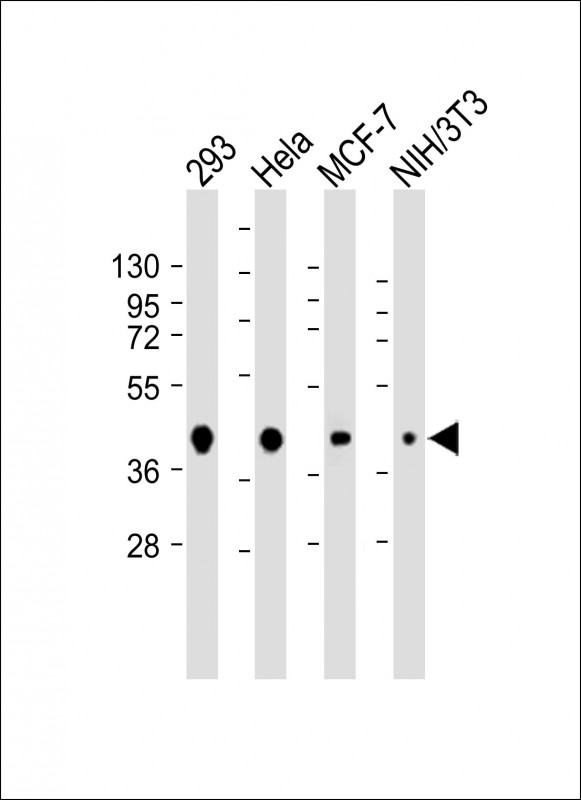
Mouse Anti-AKT1S1 antibody
PRAS40; AKT1 substrate 1 (proline rich); AKT1 substrate 1; AKT1-S1; AKT1S-1; AKT1S 1; AKT1 S1; Lobe; PRAS 40; PRAS-40; Proline rich akt substrate; 40 kDa proline rich AKT substrate; 40 kDa proline-rich AKT substrate; AKT1 substrate 1; AKTS1_HUMAN; MGC2865
View History [Clear]
Details
Product Name AKT1S1 Chinese Name AKT1S1单克隆抗体 Alias PRAS40; AKT1 substrate 1 (proline rich); AKT1 substrate 1; AKT1-S1; AKT1S-1; AKT1S 1; AKT1 S1; Lobe; PRAS 40; PRAS-40; Proline rich akt substrate; 40 kDa proline rich AKT substrate; 40 kDa proline-rich AKT substrate; AKT1 substrate 1; AKTS1_HUMAN; MGC2865; Proline rich Akt substrate 40 kDa; Proline-rich AKT1 substrate 1. Research Area Cell biology Neurobiology Signal transduction Cyclin transcriptional regulatory factor Kinases and Phosphatases Immunogen Species Mouse Clonality Monoclonal Clone NO. F6F22 React Species Human, Mouse, Applications WB=1:1000-2000
not yet tested in other applications.
optimal dilutions/concentrations should be determined by the end user.Theoretical molecular weight 28kDa Cellular localization cytoplasmic Form Liquid Concentration 1mg/ml immunogen Recombinant human AKT1S1. Lsotype IgG1,κ Purification affinity purified by Protein G Buffer Solution 0.01M TBS(pH7.4) with 1% BSA, 0.03% Proclin300 and 50% Glycerol. Storage Shipped at 4℃. Store at -20 °C for one year. Avoid repeated freeze/thaw cycles. Attention This product as supplied is intended for research use only, not for use in human, therapeutic or diagnostic applications. PubMed PubMed Product Detail AKT1S1 is a proline-rich substrate of AKT (MIM 164730) that binds 14-3-3 protein (see YWHAH, MIM 113508) when phosphorylated (Kovacina et al., 2003 [PubMed 12524439]).[supplied by OMIM, Mar 2008]
Function:
Subunit of mTORC1, which regulates cell growth and survival in response to nutrient and hormonal signals. mTORC1 is activated in response to growth factors or amino-acids. Growth factor-stimulated mTORC1 activation involves a AKT1-mediated phosphorylation of TSC1-TSC2, which leads to the activation of the RHEB GTPase that potently activates the protein kinase activity of mTORC1. Amino-acid-signaling to mTORC1 requires its relocalization to the lysosomes mediated by the Ragulator complex and the Rag GTPases. Activated mTORC1 up-regulates protein synthesis by phosphorylating key regulators of mRNA translation and ribosome synthesis. mTORC1 phosphorylates EIF4EBP1 and releases it from inhibiting the elongation initiation factor 4E (eiF4E). mTORC1 phosphorylates and activates S6K1 at 'Thr-389', which then promotes protein synthesis by phosphorylating PDCD4 and targeting it for degradation. Within mTORC1, AKT1S1 negatively regulates mTOR activity in a manner that is dependent on its phosphorylation state and binding to 14-3-3 proteins. Inhibits RHEB-GTP-dependent mTORC1 activation. Substrate for AKT1 phosphorylation, but can also be activated by AKT1-independent mechanisms. May also play a role in nerve growth factor-mediated neuroprotection.
Subunit:
Part of the mammalian target of rapamycin complex 1 (mTORC1) which contains MTOR, MLST8, RPTOR, AKT1S1/PRAS40 and DEPTOR. mTORC1 binds to and is inhibited by FKBP12-rapamycin. Interacts directly with RPTOR. The phosphorylated form interacts with 14-3-3 proteins.
Subcellular Location:
Cytoplasm, cytosol.
Tissue Specificity:
Widely expressed with highest levels of expression in liver and heart. Expressed at higher levels in cancer cell lines (e.g. A-549 and HeLa) than in normal cell lines (e.g. HEK293).
Post-translational modifications:
Phosphorylated by AKT1. Phosphorylation relieves inhibitory function on mTORC1.
Similarity:
Belongs to the ubiquitin-conjugating enzyme family.
SWISS:
Q96B36
Gene ID:
84335
Database links:Entrez Gene: 84335 Human
Entrez Gene: 67605 Mouse
SwissProt: Q96B36 Human
SwissProt: Q9D1F4 Mouse
Product Picture
Bought notes(bought amounts latest0)
No one bought this product
User Comment(Total0User Comment Num)
- No comment



 +86 571 56623320
+86 571 56623320




